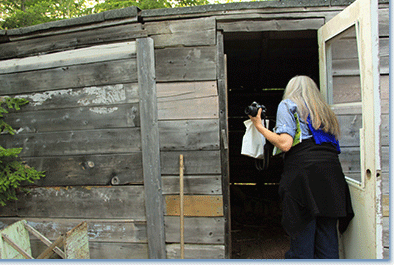It’s par for the course for conference attendees to arrive with a story of difficulty—flights missed, hotel reservations lost, WiFi dropped, and uncertain food—we’ve all experienced some or all of these troubles on our way to an annual gathering. When the first arrivals began to trickle in to the Vernacular Architecture Forum’s (VAF) annual meeting, in Gaspé, Quebec, the stories were more like the mythic hero’s journey than the typical business traveller’s gripe.
This year the meeting in Gaspé (from Mi‘kmaq for “land’s end”) required an average of between 9 to 12 hours overland, usually by car from Quebec, the nearest city. Many drove (18+ hours) from US cities such as Boston and New York, where there are concentrations of university programs, museums, and historic sites that study the vernacular landscape. Those who made the trek—and there were those who, like the early homesteaders, were forced to turn back due to inclement weather—were rewarded with extraordinary vistas of sloping cliffs and rocky shorelines, immediately conveying a sense of being dwarfed or cut down to size by the vast landscape.
As the VAF website succinctly states, “Vernacular architecture refers to ordinary buildings and landscapes,” or roughly everything in the built landscape not designed by professional architects. The location and format of the annual meeting is chosen to provide the attendees with an intensive education in the local resources, a format that has its roots in early American history, archaeology, folklife, and anthropology, in which field work is the centrepiece of research. As they do each year, members of the VAF meet in a new, often nonurban location with comfortable walking shoes, notebooks, and many, many cameras. They spend about 70 percent of the meeting looking at vernacular architecture in the field, and about 25 percent in meetings and papers—a far different ratio than most academic conferences.
One of the many benefits of this model, besides the exhaustive education in the history and architecture of a specific region, is the opportunity to truly meet and engage with the rest of the group. You might find yourself on the bus, seated next to a person whose work you’ve long admired, or across the table at lunch from the young faculty member whose first book just won an important prize. By the end of four days, you’ve not just met many new people, you’ve gotten to know them through the shared enterprise of practice. The conference has always involved a great deal of poking around—the conference as field work or practice—but this year’s edition in Gaspé took that idea a step further through engaging with the community in a series of discussions about the preservation and interpretation of their resources.
The VAF came to Gaspé at the behest of conference organizer Tania Martin, who has been conducting a field school during the summers with her students from Université Laval to document the buildings and landscapes of the disappearing Gaspésie fishing villages that dotted the coastline beginning in the 16th century. True to the VAF spirit, two separate buses were chartered to take attendees on a loop of the north and south coast of the peninsula, stopping to visit the small villages and towns nestled in the bays, where families that had made their living through fishing and logging now found themselves turning to tourism as their traditional livelihoods were eroded.
On the last day of the conference, when the paper sessions were held, Martin organized a series of roundtable discussions, delivered like the entire conference, in both French and English. The VAF participants had visited the sites and could now talk knowledgably with the inhabitants about a variety of challenges they faced, from interpreting multicultural, multilingual sites, to conserving buildings and landscapes when there is little money or will. There were moments of levity—the Gaspésians found it very droll that the VAFers spent so much looking under staircases and poking walls—but with very high unemployment; an aging population; multiple, distinct cultural, religious, and language orientations; and no industry to sustain it, Gaspé’s issues are complex. Many VAFers confront these issues in their own work, and it was extremely important to the local community to have the attendees there and to be able to ask them for help and perspective.
Next year, the conference is in South Jersey, and the VAFers will march through the cranberry bogs, the 19th-century farms, the old whaling villages, the tony and not-so-tony beachside resorts, and the rest of the cultural landscape of “down Jersey.” Hope to see you there.
This post first appeared on AHA Today.
Tags: AHA Today 2014 Annual Meeting Public History Teaching & Learning
Comment
Please read our commenting and letters policy before submitting.







